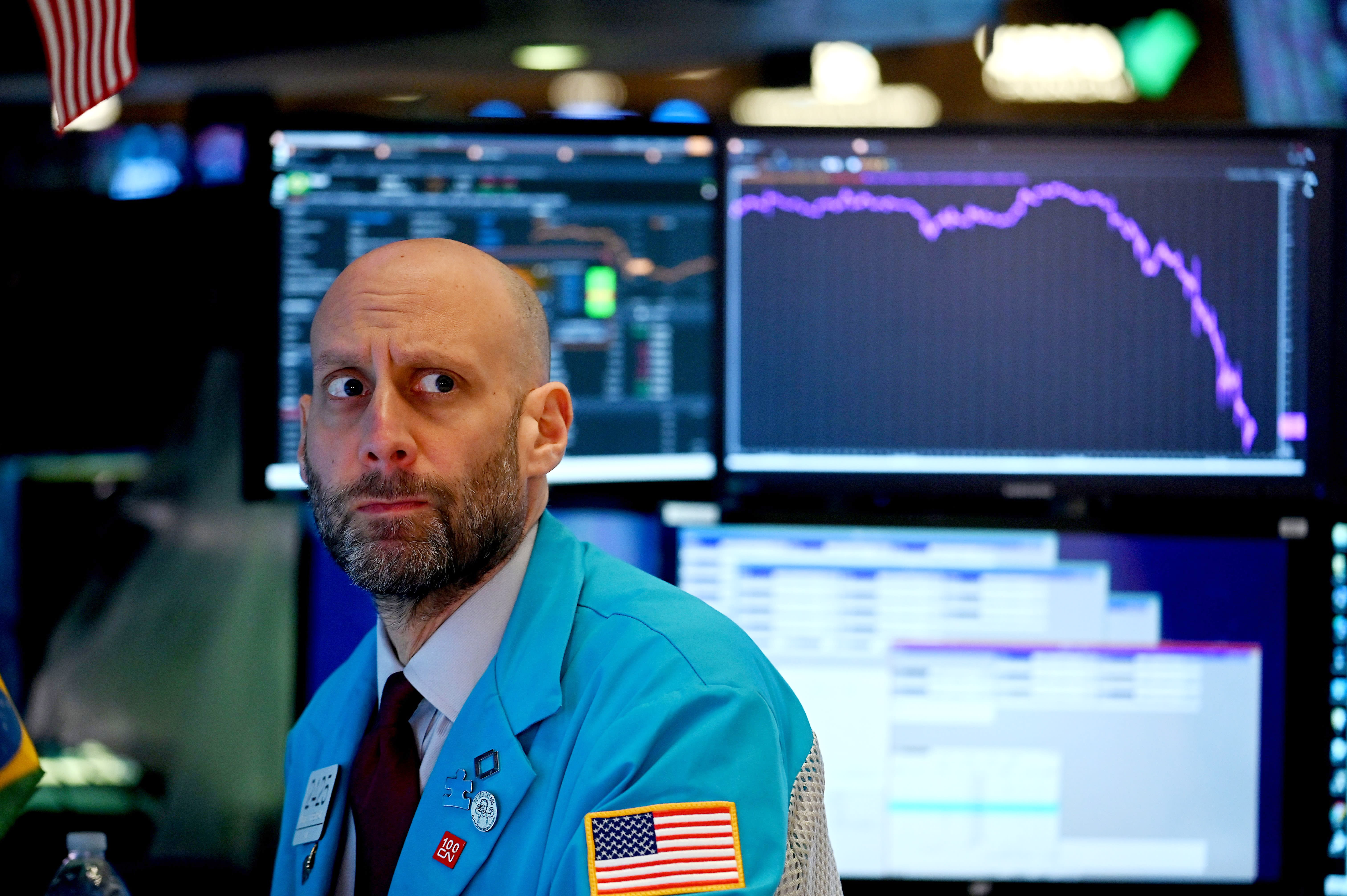
Stocks tumbled on Wednesday — triggering yet another trading halt and reaching a new coronavirus crisis low as the markets remained highly volatile with the government response to the outbreak still unfolding.
The S&P 500 was down 8.9% after a marketwide “circuit breaker” was tripped up just before 1 p.m. ET. The Dow Jones Industrial Average dropped 2,000 points, or more than 9%. Wednesday’s drop also erased the Dow’s gains since President Donald Trump’s inauguration on January 2017. The Nasdaq Composite slid 7.9%.
A circuit breaker halts trading across the U.S. stock exchanges for 15 minutes and is meant to ensure orderly market behavior. Wednesday market the fourth time in a week that a circuit breaker was triggered.
Investors on Wednesday digested new details from a possible stimulus package to mitigate the economic damage from the outbreak.
Dow Jones reported on Wednesday the Treasury Department is proposing two rounds of direct payments to citizens, which total $250 billion. Those payments, according to the report, would begin April 6. Treasury is also asking permission to backstop money markets, according to the report.
However, some think the government should take even more drastic measures.
Bill Ackman, billionaire investor and founder of Pershing Square Capital Management, said the best remedy for the market downturn and the outbreak in the U.S. is for President Donald Trump to shut down the country.
“Mr. President, the only answer is to shut down the country for the next 30 days and close the borders. Tell all Americans that you are putting us on an extended Spring Break at home with family,” Ackman said on Twitter. “The moment you send everyone home for Spring Break and close the borders, the infection rate will plummet, the stock market will soar, and the clouds will lift.”
The number of confirmed U.S. coronavirus cases has jumped to more than 6,400, according to data from Johns Hopkins University, while the death count has broken above 100.
Wall Street has been on an unprecedented roller-coaster ride amid the coronavirus turmoil, with the S&P 500 swinging 4% or more in either direction for seven consecutive sessions through Tuesday’s close. This tops the previous record of six days from November 1929, according to LPL Financial. Stocks continued their volatile streak on Wednesday, with another drop of more than 4%. The S&P 500 is 29.5% off its record high through Wednesday.
“Volatility is not over yet,” said Tom Essaye, founder of The Sevens Report, in a note. He pointed out the administration’s stimulus packages need congressional approval. “We also need to see more progress on the pharma side of things, and above all else we need the growth rate of the virus to peak in the coming weeks.”
A violent reversal in Treasury yields in response to a potential $1 trillion stimulus package helped to unnerve investors.
The 10-year Treasury yield jumped to 1.103% Wednesday after trading around 0.77% midday Tuesday before details of the potential stimulus emerged. It began the week at around 0.65%. It wasn’t the outright rate level that caused uneasiness among traders, but the rapid nature of the move overnight.
“When you decimate the restaurant industry, the travel industry, the hotel industry, the airline industry .. the cruise line industry, obviously you’re going to take a huge divot out of economic activity,” DoubleLine Capital CEO Jeffrey Gundlach said on a webcast Tuesday after the bell. Gundlach put the odds of a recession at 90% and said it was “ludicrous” to think otherwise. He added he believes the stimulus will end up being even bigger than $1 trillion.
Gundlach also commented on the reversal higher in Treasury yields, noting it could put the U.S. in the uncomfortable position of having both a weak economy and rising rates, as new debt issuance to pay for the stimulus floods the bond market.
Treasurys are the latest market to see extreme moves. The recent overnight trading of futures contracts has seen unusual volatility, leaving many investors to believe computer trading has exaggerated moves in the market’s collapse stemming from the coronavirus outbreak.
The movement comes amid historic highs on the Cboe Volatility Index, which closed above its 2008 financial crisis peak on Monday. That index looks at options prices for the S&P 500 and is also known as the “fear gauge” of Wall Street.
On Tuesday, the markets rebounded from their deepest rout since 1987 as investors grew hopeful that the Trump administration’s massive fiscal stimulus plans will rescue the economy, which is at risk of falling into a recession due to the coronavirus impact.
The Dow soared more than 1,000 points on Tuesday to cap off another volatile session, making back less than half of Monday’s steep losses.
On Tuesday, investors also cheered the Federal Reserve’s amped-up effort to help companies having a hard time getting short-term funding. The bank announced a special credit facility to purchase corporate paper from some issuers. This follows the Fed’s emergency $700 billion quantitative easing program and a further 100 basis point cut to interest rates on Sunday.
—CNBC’s Pippa Stevens, Eustance Huang and Christine Wang contributed to this report.
Subscribe to CNBC PRO for exclusive insights and analysis, and live business day programming from around the world.

